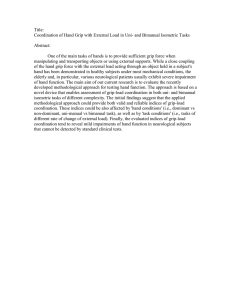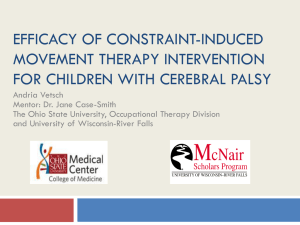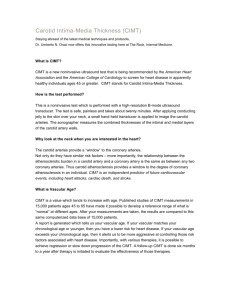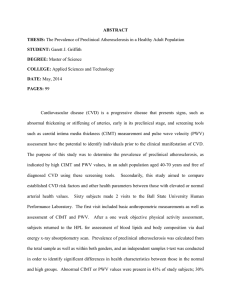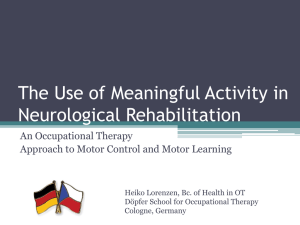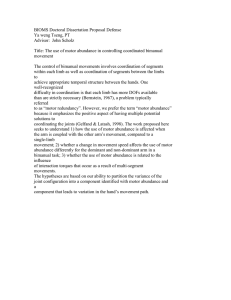Title: Prepared by for children with spastic hemiparesis secondary to Cerebral Palsy.
advertisement
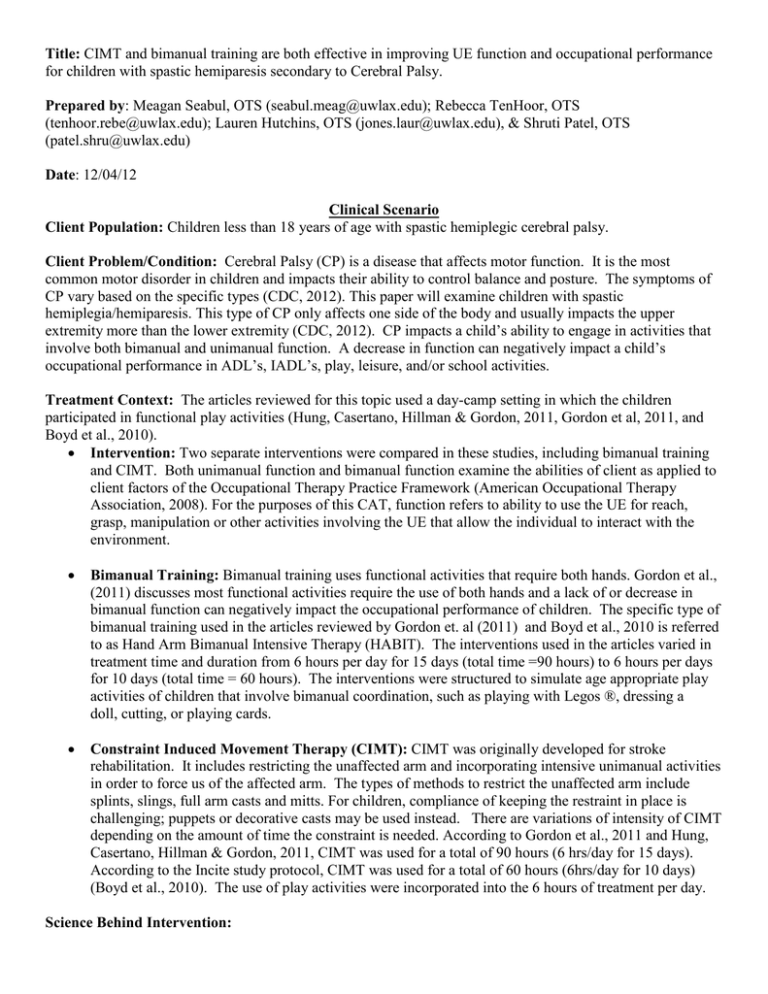
Title: CIMT and bimanual training are both effective in improving UE function and occupational performance for children with spastic hemiparesis secondary to Cerebral Palsy. Prepared by: Meagan Seabul, OTS (seabul.meag@uwlax.edu); Rebecca TenHoor, OTS (tenhoor.rebe@uwlax.edu); Lauren Hutchins, OTS (jones.laur@uwlax.edu), & Shruti Patel, OTS (patel.shru@uwlax.edu) Date: 12/04/12 Clinical Scenario Client Population: Children less than 18 years of age with spastic hemiplegic cerebral palsy. Client Problem/Condition: Cerebral Palsy (CP) is a disease that affects motor function. It is the most common motor disorder in children and impacts their ability to control balance and posture. The symptoms of CP vary based on the specific types (CDC, 2012). This paper will examine children with spastic hemiplegia/hemiparesis. This type of CP only affects one side of the body and usually impacts the upper extremity more than the lower extremity (CDC, 2012). CP impacts a child’s ability to engage in activities that involve both bimanual and unimanual function. A decrease in function can negatively impact a child’s occupational performance in ADL’s, IADL’s, play, leisure, and/or school activities. Treatment Context: The articles reviewed for this topic used a day-camp setting in which the children participated in functional play activities (Hung, Casertano, Hillman & Gordon, 2011, Gordon et al, 2011, and Boyd et al., 2010). • Intervention: Two separate interventions were compared in these studies, including bimanual training and CIMT. Both unimanual function and bimanual function examine the abilities of client as applied to client factors of the Occupational Therapy Practice Framework (American Occupational Therapy Association, 2008). For the purposes of this CAT, function refers to ability to use the UE for reach, grasp, manipulation or other activities involving the UE that allow the individual to interact with the environment. • Bimanual Training: Bimanual training uses functional activities that require both hands. Gordon et al., (2011) discusses most functional activities require the use of both hands and a lack of or decrease in bimanual function can negatively impact the occupational performance of children. The specific type of bimanual training used in the articles reviewed by Gordon et. al (2011) and Boyd et al., 2010 is referred to as Hand Arm Bimanual Intensive Therapy (HABIT). The interventions used in the articles varied in treatment time and duration from 6 hours per day for 15 days (total time =90 hours) to 6 hours per days for 10 days (total time = 60 hours). The interventions were structured to simulate age appropriate play activities of children that involve bimanual coordination, such as playing with Legos ®, dressing a doll, cutting, or playing cards. • Constraint Induced Movement Therapy (CIMT): CIMT was originally developed for stroke rehabilitation. It includes restricting the unaffected arm and incorporating intensive unimanual activities in order to force us of the affected arm. The types of methods to restrict the unaffected arm include splints, slings, full arm casts and mitts. For children, compliance of keeping the restraint in place is challenging; puppets or decorative casts may be used instead. There are variations of intensity of CIMT depending on the amount of time the constraint is needed. According to Gordon et al., 2011 and Hung, Casertano, Hillman & Gordon, 2011, CIMT was used for a total of 90 hours (6 hrs/day for 15 days). According to the Incite study protocol, CIMT was used for a total of 60 hours (6hrs/day for 10 days) (Boyd et al., 2010). The use of play activities were incorporated into the 6 hours of treatment per day. Science Behind Intervention: The theory of neuronal plasticity (also referred to as neuroplasticity) is the basic science concept that explains both CIMT and bimanual training. Neuronal plasticity permits reorganization of the central nervous system through the development of new neural pathways. Lesions or damage to a specific area of the brain lead to impaired function; the structure damaged is directly correlated to the function that is impaired. For example, if the primary motor cortex of the left hemisphere is damaged, this damage will manifest in the contralateral side of the body. Neuronal plasticity allows the function or structures of the brain to reorganize in order to promote functional recovery of the client. The reorganization can remain in the affected hemisphere, switch to the opposite hemisphere, or can be shared by both hemispheres (Johnston, 2009). When the unaffected arm is restricted, the affected arm is forced to move during the activity in which the brain creates alternative motor pathways to conduct the desired movement. Both CIMT and bimanual training use concepts from motor learning principles by incorporating the type of task being practiced and the amount of feedback that is provided. New motor schemas are created through repeated practice which can cause an increase in brain activation patterns and create new neuronal motor pathways. This increases motor neuron groups, which may help retain motor skill learning and help produce functional improvements (Hubbard, Parsons, & Carey, 2009). In addition to cortical reorganization, CIMT utilizes forced use to overcome the idea of learned nonuse. This is done by applying a cast, sling, or mitt to the client’s non-affected UE, forcing the client to use his/her affected UE during everyday activities. Current research indicates that forced use can result in an increase in hemispheric activation of the involved side, as well as possible growth and synapse formation of corticospinal fibers. Improved function in the affected UE is believed to be caused by these changes within the brain, allowing the client to more effectively use his/her affected UE (Huang, Chen, Chien, Kashima, Lin, 2011). Application to Occupational Therapy: CIMT and bimanual training are interventions that can be used as preparatory, purposeful, or occupation-based methods. The articles reviewed incorporated meaningful activities (play) into both the CIMT and bimanual interventions in order to improve function. This uses the occupational therapy premise of using occupational therapy as both the means and the end. A fundamental occupation of children is play, by incorporating the use of play into an intervention, the outcome of improving function in order to promote play can be achieved. These articles used CIMT and bimanual therapies as purposeful activities that incorporated age appropriate activities (American Occupational Therapy Association, 2008). Application to the Occupational Therapy Domain and Framework: CIMT and bimanual training interventions incorporate several aspects of the Occupational Domain and Framework. These include neuromusculoskeletal and movement-related functions (body functions), such as control of voluntary movement, joint mobility, muscle power, muscle tone, and muscle endurance. In addition, motor and praxis skills (performance skills) are addressed, as the client works to improve his/her ability to reach, grasp, and manipulate objects. The mentioned neuromuscular and movement-related functions, as well as the motor and praxis skills contribute to improve overall unilateral and bimanual function. In the articles reviewed, both the CIMT and bimanual training intervention were administered using purposeful activities, as the client participated in activities used to develop skills for his/her engagement in occupation. PICO Question: What is the impact of CIMT compared to bimanual training on UE function and occupational performance for children with hemiparesis secondary to Cerebral Palsy? Summary: The intent of this CAT was to determine what the impact of CIMT or bimanual training is in improving UE function and occupational performance for children with spastic hemiparesis secondary to Cerebral Palsy. Three databases were searched and 11 relevant articles were located. • Number of articles of each level o Level 1b: 9 articles o Level 4: 1 article o Level 5: 1 article The current research comparing CIMT to bimanual training is limited. Therefore, the articles reviewed were selected based on similar outcome measures which were relevant to our PICO question. There are other articles that compare CIMT to bimanual training by examining factors such as coordination or quality of life. However, these articles were not selected due to the fact comparison of these factors between multiple articles was not possible. Overall, all studies demonstrated significant improvement on all measures regardless of which intervention method was used. CLINICAL BOTTOM LINE: There is strong evidence that either CIMT or bimanual training significantly improve UE function and occupational performance for children with hemiparesis secondary to Cerebral Palsy. Limitation of this CAT: This critically appraised paper has been reviewed by occupational graduate students and the course instructor. Table 1: Search Strategy Databases Searched Search Terms 1) EBSCO host Health Professions database CIMT and Bimanual Training and Cerebral Palsy CIMT and Bimanual Training Limits used Inclusion and Exclusion Criteria None -Literature must be < 10 yrs -English only 2) Cinahl Plus w/ Full text (EBSCO host) 3) Cochrane Register of Controlled Trials Table 2: Summary of Study Designs of Articles Retrieved Level Study Design/ Methodology of Articles Retrieved Level 1a Systematic Reviews or Metanalysis of Randomized Control Trials Level 1b Individualized Randomized Control Trials Total Number Located Database Source Main articles Citation (Name, Year) Sub articles Citation (Name, Year) 2* Gordon, Hung, Brandao, EBSCO HOST: Ferre, Kuo, Friel, &... Health Professions Data Charles, (2011). Base Boyd, Sakzewski, Ziviani, Abbott, Badawy, CINAHL PLUS Gilmore, & ... Jackson, with Full Text (2010). (EBSCO HOST) Hung, Casertano, Hillman, & Gordon, (2011). (2 sub articles from Gordon et al.) (5 sub articles from Boyd et al.) de Brito Brandao, Gordon, & Mancini (2012). Sakzewski Carlon, Shields, Ziviani, Ware, & Boyd (2012). Sakzewski, Ziviani, & Boyd (2011). Sakzewski, Ziviani, & Boyd (2010). Sakzewski, Ziviani, Abbott, Macdonell, Jackson, & Boyd (2011). Sakzewski, Ziviani, Abbott, Macdonell, Jackson, & Boyd (2011). Level 2a Systematic reviews of cohort studies Level 2b Individualized cohort studies and low quality RCT’s (PEDRO < 6) Level 3a Systematic review of case-control studies Level 3b Case-control studies and non-randomized controlled trials Level 4 Case-series and poor quality cohort and case-control studies 1 Level 5 Expert Opinion 1 EBSCO HOST: Health Professions Data Base CINAHL PLUS with Full Text (EBSCO HOST) Gordon, (2011). Sakzewski, (2012). Table 3: Summary of Articles Study 1 Boyd, R., Sakzewski, L., Ziviani, J., Abbott, D., Badawy, R., Gilmore, R., & ... Jackson, G. (2010). Study 1a. Sakzewski, L., Ziviani, J., Abbott, D., Macdonell, R., Jackson, G., & Boyd, R. (2011) Study 1b. Sakzewski, L., Ziviani, J., Abbott, D., Macdonell, R, Jackson, G., & Boyd, R. (2011) (activity outcomes) (participation outcomes) Study 2. Gordon, A. M., Hung, Y., Brandao, M., Ferre, C. L., Kuo, H., Friel, K., & ... Charles, J. R. (2011) Study 2a. de Brito Brandao, M., Gordon, A.M., & Mancini, M.C. (2012). Design and PEDRO rating Design: RCT RCT PEDRO rating: 6/8 6/8 RCT 6/8 RCT 6/8 RCT 5/8 Population Children 5-16 Children 5-16 with with congenital congenital hemiplegic hemiplegic cerebral palsy cerebral palsy Children 5-16 with congenital hemiplegic cerebral palsy Children ages 3.5-10 Children ages 3.5-10 with with congenital hemiplegic congenital hemiplegic cerebral palsy cerebral palsy Intervention CIMT Investigated CIMT CIMT CIMT CIMT Comparison Bimanual Intervention training Bimanual training Bimanual training Bimanual training (hand-arm intensive bimanual therapy: HABIT) Bimanual training (handarm intensive bimanual therapy: HABIT) Dependent Variables 1. unilateral function 2. bimanual function 1. performance 2. satisfaction 1. unilateral function 2. bimanual function 3. goal attainment 1. performance 2. satisfaction 3.self-care 4. independence Outcome Measures 1a. Melbourne Assessment of Unilateral Upper Limb Function (MUUL) 1b. Jebsen Taylor Test of Hand Function (JTTHF) 2. Assisting Hand Assessment (AHA) 1&2. COPM 1. JTTHF 2. AHA 3. Goal Attainment Scale (GAS) 1. COPM 2. COPM 3. Self-Care Functional Skills scale 4. Caregiver Assistance Scale Note: 3 & 4 were subtests of the PEDI (Pediatric Evaluation Disability Inventory) Both groups demonstrated statistically significant improvements from baseline to 26 weeks on the JTTHF. Both groups demonstrated statistically significant improvement from baseline to follow-up on the COPM. Results from the JTTHF indicate both groups demonstrate statistically significant improvement from pre-test to 6 mos. post-test. Results from the COPM demonstrated no statistically significant difference between the CIMT and HABIT group. However, both groups demonstrated clinically important improvements in both performance and satisfaction. Results N/A CIMT had longerstanding benefits for unilateral function as measured by the MUUL. At 26 weeks there was a statistically significant difference between the two groups, with the CIMT group demonstrating improved unilateral function. Bimanual training retained the benefits based on the results from the AHA. 66% of participants achieved a clinically significant change of 2 points or greater for COPM performance from baseline to 3 weeks. A 2-point change was set as clinically significant. Results from the AHA indicate both groups demonstrated statistically significant improvement from pre-tests to 6 mos. post-test. Both groups significantly improved for all goals measured by the GAS. This includes goals that were practiced during treatment, as well as Results from the Self-Care Functional Skills Scale indicated both groups improved. The Caregiver Assistance Scale showed both groups improved in independence. There were no differences between groups for any of the above measures. goals that were not practiced during treatment. Effect Size Conclusion Effect Sizes were not calculated for any of the articles due to lack of data. CIMT demonstrates improved unilateral performance. Bimanual training improved bimanual performance. Both CIMT and bimanual training result in improved occupational performance and satisfaction. Similar improvements resulted from either CIMT or bimanual training (HABIT). Similar improvements resulted from either CIMT or bimanual training (HABIT). Synthesis PICO Question: What is the impact of CIMT compared to bimanual training on UE function and occupational performance for children with hemiparesis secondary to Cerebral Palsy? Overall conclusions: Overall, all studies demonstrated significant improvement on all measures, regardless of which intervention method was used. • Occupational Performance: The CIMT and bimanual training groups both demonstrated statistically significant improvements in occupational performance, satisfaction and goal attainment. However, Gordon et al. (2011) found statistically significant differences in unpracticed goals between the CIMT and bimanual groups as measured by the Goal Attainment Scale (GAS), with the bimanual group demonstrating greater improvements. • Unimanual and Bimanual Function: Overall, both CIMT and bimanual training resulted in statistically significant initial improvements of unimanual function and bimanual function. However, Sakzewski, Ziviani, Abbott, Macdonell, Jackson, & Boyd (2011) found both the CIMT and bimanual groups demonstrated significant improvements in the quality of unimanual function (as measured by the MUUL) at 3 weeks, but only the CIMT group maintained these gains at 6 months. Gordon et al. (2011) and Saksewski et al. (2011) also used the Jebsen Taylor Test of Hand Function (JTTHF) as an outcome measure of unimanual function. Contrary to the outcomes measured by the MUUL, both of these studies found statistically significant improvements for both the CIMT and bimanual training groups when the JTTHF was used. For bimanual capacity, Sakzewski et al. (2011) found both the CIMT and bimanual groups demonstrated significant improvements (as measured by the AHA) at 3 weeks, but only the bimanual group maintained these gains at 6 mos. Impact of Study Differences: • Differences in assessments: o The JTTHF is a quantitative seven-part, timed, diagnostic test that is used to determine the level of unimanual hand function. It includes seven subtests: writing; simulated page turning; lifting small objects; simulated feeding; stacking; lifting large, lightweight boxes; lifting large, heavy boxes. o The MUUL is a qualitative assessment that consists of sixteen test items and examines unilateral upper limb function in children. The test items include tasks such as reaching, grasping, pronation, supination, and hand-to-hand transfers. Detailed scoring and interpretation instructions are provided for each test item to help ensure objectivity. o Although both assessments examine unilateral capacity of the affected upper extremity, the JTTHF examines the quantity of movement and the MUUL examines the quality of movement. It is possible that this discrepancy explains the differences in outcomes reported in the above section. • Treatment Dosage: The differences noted between the two groups measured by the AHA could be attributed to differences in total treatment time. Although both studies showed statistically significant initial gains, only one study (Gordon et al., 2011) showed the gains maintained at a 6 month follow up. This study had a total treatment time of 90 hours, 6 hours/day for 15 days; whereas the study that showed differences between groups at 6 month follow up had a total treatment time of 60 hours, 6 hours/day for 10 days. It is possible that the additional 30 hours of treatment time attributed to the CIMT group maintaining the initial gains at 6 months. • Limitations: The variables of performance, satisfaction, and goal attainment examine activity participation or occupational performance. The COPM and GAS are client-centered assessment tools that involve the client in the goal setting process. Although these assessments allow the client to select meaningful occupations to address in therapy, they do not place limitations on “how” the client is expected to perform the occupations. For example, in the studies reviewed, a child or his/her parent may have set a goal related to self-feeding. However, neither the COPM nor GAS specifies that this task will be done with the use of the affected upper extremity. Although performance or satisfaction with the goal may have improved, this does not directly correlate to the improvements in the affected upper extremity. It is possible that compensatory techniques were used in order to improve performance on the task. Boundaries: Application of the findings should be limited to the criteria outlined below: • Population: Altogether, these articles had 106 participants between the ages of 3.5 to 16 with congenital hemiplegia secondary to cerebral palsy. The average age of the children over all the studies was 8.65 years, or approximately 8 years and 8 months of age. • Inclusion Criteria: Participants had a confirmed diagnosis of congenital hemiplegia, with a Modified Ashworth Scale (MAS) of less than 3. Minimal active grasp was also required to be involved in the studies, with one study describing this as MAS between 1 and 3 for wrist flexors, forearm pronators, and/or thumb adductors, and >20 degrees of wrist extension and >10 degrees of MP extension from full flexion. Participants in both studies were also required to have the ability to understand, cooperate with, and follow therapist instruction. • Exclusion Criteria: Participants were excluded from the study if they had dystonia or contracture (MAS >3), previous orthopedic surgery in UE, or had received serial casting or Botulinum Toxin A injections in the UE 6 months prior to the study. Implications for Practice: These studies demonstrated statistically significant effects with 60-90 hours of treatment of either CIMT or bimanual training. When intervention intensity and frequency is matched, for 6 hours a day and at least 60 hours total, initial outcomes are the same for both CIMT and bimanual interventions. When the duration of the intervention is longer (90 hours total), retention of initial gains are equal at 26 weeks for both groups. Although these studies support the use of either intervention, there are other factors, such as child or parent preference, to consider when selecting an intervention. References Boyd, R., Sakzewski, L., Ziviani, J., Abbott, D., Badawy, R., Gilmore, R., & ... Jackson, G. (2010). INCITE: A randomized trial comparing constraint induced movement therapy and bimanual training in children with congenital hemiplegia. BMC Neurology, (10) 4. de Brito Branda˜o, M., Gordon, A. M., & Mancini, M. C. (2012). Functional impact of constraint therapy and bimanual training in children with cerebral palsy: A randomized controlled trial. American Journal of Occupational Therapy, 66, 672–681. Gordon, A. M., Hung, Y., Brandao, M., Ferre, C. L., Kuo, H., Friel, K., & ... Charles, J. R. (2011). Bimanual training and constraint-induced movement therapy in children with hemiplegic cerebral palsy: A randomized trial. Neurorehabilitation And Neural Repair, 25(8), 692-702. Gordon, A. (2011). To constrain or not to constrain, and other stories of intensive upper extremity training for children with unilateral cerebral palsy. Developmental Medicine & Child Neurology, (5)3, 56 61. Hung, Y., Casertano, L., Hillman, A., & Gordon, A. (2011). The effect of intensive bimanual training on coordination of the hands in children with congenital hemiplegia. Research In Developmental Disabilities, 32(6), 2724-2731. Sakzewski, L. (2012). Bimanual therapy and constraint-induced movement therapy are equally effective in improving hand function in children with congenital hemiplegia. Journal of Physiotherapy, 58(1), 59. Sakzewski, L., Carlon, S., Shields, N., Ziviani, J., Ware, R., & Boyd, R. (2012). Impact of intensive upper limb rehabilitation on quality of life: a randomized trial in children with unilateral cerebral palsy. Developmental Medicine & Child Neurology, 54(5), 415-423. Sakzewski, L., Ziviani, J., & Boyd, R. (2011). Best responders after intensive upper-limb training for children with unilateral cerebral palsy. Archives of Physical Medicine And Rehabilitation, 92(4), 578-584 Sakzewski, L., Ziviani, J., Abbott, D. F., Macdonell, R. A., Jackson, G. D., & Boyd, R. N. (2011). Participation outcomes in a randomized trial of 2 models of upper-limb rehabilitation for children with congenital hemiplegia. Archives of Physical Medicine & Rehabilitation, 92(4), 531-539. Sakzewski, L., Ziviani, J., Abbott, D., Macdonell, R., Jackson, G. D., & Boyd, R. (2011). Randomized trial of constraint-induced movement therapy and bimanual training on activity outcomes for children with congenital hemiplegia. Developmental Medicine & Child Neurology, 53(4), 313-320. Sakzewski, L., Ziviani, J., & Boyd, R. (2010). The relationship between unimanual capacity and bimanual performance in children with congenital hemiplegia. Developmental Medicine and Child Neurology, 52(9), 811-816. Other Resources American Occupational Therapy Association (2008). Occupational therapy practice framework: Domain and process (2nd ed.). American Journal of Occupational Therapy, 62, 625-682. Centers for Disease Control and Prevention. (2012). Cerebral Palsy Homepage. Retrieved October 25, 2012 from the CDC Web site: http://www.cdc.gov/ncbddd/cp/facts.html Frye, R. E. (2012). Advances and limitations in our knowledge of cortical reorganization in cerebral palsy. Developmental Medicine & Child Neurology, 54(4), 298-299 Huang, C., Chen, Y., Chien, C., Kashima, H., & Lin, K. (2011). Constraint-induced movement therapy as a paradigm of translational research in neurorehabilitation: Reviews and prospects. American Journal of Translational Research, 3(1), 48-60. Retrieved from: http://www.ncbi.nlm.nih.gov/pmc/articles/PMC2981425/ Hubbard, I. J., Parsons, M. W., Neilson, C., & Carey, L. M. (2009). Task-specific training: Evidence for and translation to clinical practice. Occupational Therapy International, 16(3-4), 175-189.
